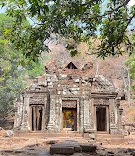Vat Pho Temple , Laos
📍 Discover Vat Phou
Located near the town of Champasak in southern Laos, Vat Phou is a UNESCO World Heritage Site and one of the most important historical and spiritual landmarks in the country. Unlike the crowded temples of Cambodia or Thailand, Vat Phou feels like a secret waiting to be uncovered—serene, sacred, and surrounded by nature.
🏛️ What Makes Vat Phou Special?
🕰️ Ancient Khmer Roots
-
Vat Phou dates back to the 5th century, making it centuries older than Angkor Wat.
-
Originally a Hindu temple dedicated to Shiva, it was later adapted for Buddhist worship.
🏞️ Spiritual Architecture Meets Nature
-
Built on the side of Mount Phou Kao, the temple complex is perfectly aligned with natural sacred elements—a mountain peak as a lingam, and a natural spring running through the sanctuary.
-
Its design blends deeply with the surrounding landscape in a way that feels almost mystical.
🧭 What to See at Vat Phou
🔹 The Processional Causeway
Begin your journey on the wide avenue lined with sandstone pillars, leading you up toward the temple terraces.
🔹 Twin Pavilions
Two large buildings believed to be used for ceremonies or pilgrim housing. Their exact purpose remains a mystery, adding to the temple’s allure.
🔹 The Upper Sanctuary
Climb the stone steps to the highest point—where the shrine houses sacred relics and a constantly flowing spring believed to have healing properties.
🔹 Carvings & Reliefs
Intricate carvings of Hindu deities, nagas (serpent spirits), and celestial dancers (apsaras) can still be seen etched into the stone, whispering tales of centuries past.
🌅 When to Visit
-
Best Time: November to February, when temperatures are cooler and skies are clear.
-
Sunrise or Sunset: Visit in the early morning or late afternoon for beautiful lighting and fewer crowds.
🚗 How to Get There
-
Base City: Pakse (around 45 minutes away by road).
-
Transport: Rent a car, take a tuk-tuk, or join a guided day tour from Pakse or Champasak.
💡 Insider Tips
-
Wear comfortable shoes—the stone stairs can be steep and uneven.
-
Bring water and sun protection, especially during midday.
-
Combine your visit with a trip to the 4000 Islands (Si Phan Don) or Bolaven Plateau for a fuller southern Laos experience.
✨ Why You Shouldn’t Miss Vat Phou
Vat Phou is a rare blend of ancient power, natural harmony, and spiritual serenity. It’s not just a place to take photos—it’s a place to feel connected to the earth, the sky, and centuries of human devotion. Peaceful and uncrowded, it’s a must-visit for travelers seeking meaningful, off-the-beaten-path experiences.


